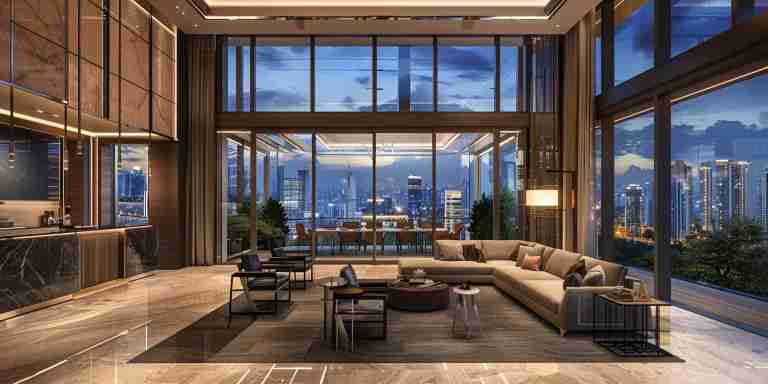When investing in a condo, financing is a crucial factor to consider. In Singapore, there are several mortgage options available, but it is crucial to be familiar with the Total Debt Servicing Ratio (TDSR) framework. This framework sets a limit on the amount of loan a borrower can take based on their income and current debt obligations. To make informed decisions about financing, investors should understand the TDSR and seek guidance from financial advisors or mortgage brokers. This thoughtful approach can prevent over-leveraging and ensure a successful investment in the real estate market.
Metal Roofing:
When it comes to real estate, one of the most critical factors that can affect the value and overall appeal of a property is its roofing. The roof is not only a crucial structural component, but it also plays a significant role in protecting the interior of the property from the external elements. Therefore, choosing the right roofing material is essential for every property owner.
Wood shingles, also known as shakes, are made from natural wood and have been used for roofing for centuries. They offer a unique and rustic look to a property and can last anywhere from 30 to 50 years if maintained properly. Wood shingles are also environmentally friendly, as they are made from natural and renewable materials.
Metal roofing has gained popularity in recent years due to its durability, longevity, and energy efficiency. Metal roofs can last anywhere from 40 to 70 years, which is significantly longer than other roofing materials. They are also fire-resistant, making them a safer option for properties in areas prone to wildfires. Additionally, metal roofs are lightweight, making them easier to install, and they come in a range of colors and styles to suit different preferences.
However, metal roofs can be expensive, with the cost being two to three times higher than asphalt shingles. They can also be noisy during rain or hailstorms, and their installation requires specialized skills and equipment, which can add to the cost. Metal roofs are also not suitable for every property’s aesthetic, and they may not be allowed in historical or conservation areas.
Asphalt shingles are the most commonly used roofing material in the United States. They are relatively affordable, easy to install, and have a lifespan of about 20 to 30 years. Asphalt shingles are available in a wide range of colors and styles, making them a popular choice among homeowners. They are also relatively low maintenance, making them an attractive option for those looking for a hassle-free roofing solution.
Slate roofing is one of the most expensive roofing options, but it also offers unmatched durability and longevity. It can last up to 100 years with minimal maintenance and is highly resistant to fire, wind, and water. Slate tiles are also available in various sizes, colors, and thickness, allowing for a customized and unique look for each property.
However, these roofing materials come with a high upfront cost, which can be a significant drawback for some property owners. They are also heavy, and their installation requires additional support, which can add to the overall cost. In addition, clay or concrete tiles are fragile and can easily crack or break, especially if walked on. Their weight and fragility also make them challenging to install and repair, which can add to the cost and time.
In conclusion, choosing the right roofing material for your property is a crucial decision that requires careful consideration of several factors. While each material has its advantages and disadvantages, it ultimately comes down to your budget, personal preferences, and the climatic conditions of your area. Whichever material you choose, make sure to consult with a professional roofing contractor to ensure a proper and safe installation. With the right roofing material, your property will not only be well-protected but also aesthetically pleasing for years to come.
To successfully invest in property in Singapore, foreign investors must familiarize themselves with the laws and limitations in place. Unlike landed properties, the purchase of condos is typically less restricted for foreigners. However, foreign buyers are required to pay the Additional Buyer’s Stamp Duty (ABSD) of 20% for their initial property purchase. Despite this added expense, the stability and potential for growth in the Singapore real estate market continues to attract foreign interest. Therefore, it is imperative for foreign investors to carefully navigate these regulations and thoroughly consider the long-term potential before making any investments. It is crucial for these investors to adhere to these regulations and ensure that their property investment is free of any copycat strategies. This is not only necessary for safeguarding their investment, but also for preserving the integrity of the Singapore real estate market. By respecting and adhering to these regulations, foreign investors not only protect their own interests, but also contribute to the ongoing strength and stability of the market.
When purchasing a condo, financing is a crucial factor to consider. Singapore has multiple mortgage opportunities available, but it’s imperative to take note of the Total Debt Servicing Ratio (TDSR) guidelines. These rules restrict the loan amount a borrower can take, considering their income and current debt commitments. Being knowledgeable about the TDSR and consulting with financial experts or mortgage specialists can assist investors in making well-informed choices regarding their financing strategies and preventing excessive borrowing.
Therefore, it is crucial for foreign investors to carefully navigate the regulations and consider the long-term potential before investing in Singaporean properties. It is imperative that these investors adhere to these regulations and ensure that their property investment is in compliance. This is not only crucial for protecting their investment, but also for maintaining the integrity of the Singapore real estate market. Ensuring this compliance will not only benefit the investors, but also contribute to the continued growth and stability of the market.
Clay or Concrete Tiles:
Clay or concrete tiles are known for their durability and longevity. These materials can last up to 100 years, making them a one-time investment for property owners. They are also fire-resistant, energy-efficient, and require very little maintenance. Clay or concrete tiles can also add an elegant and luxurious look to a property, making it stand out in the neighborhood.
However, wood shingles are prone to fire, rot, and insect infestations, which can significantly reduce their lifespan. They also require regular maintenance, including staining or painting, to prevent decay. Wood shingles are also relatively expensive and generally not suitable for properties in areas with high humidity, as they can warp and crack.
Slate Roofing:
However, the high cost of slate roofing can be a significant deterrent for many property owners. It is also extremely heavy, and like clay or concrete tiles, it requires additional support for installation. Additionally, walking or working on a slate roof can cause it to crack or break, leading to expensive repairs.
However, one of the major drawbacks of asphalt shingles is that they are not very durable. They can easily get damaged by strong winds, heavy rain, and extreme temperatures. They are also not very eco-friendly, as they are made from petroleum-based materials, which can harm the environment. Additionally, they are not the most visually appealing option and may not add much aesthetic value to your property.
With a wide range of roofing materials available in the market, it can be overwhelming and challenging to decide which one is the best for your property’s roofing needs. Each material has its unique characteristics, benefits, and drawbacks, which can make the decision-making process even more complicated. To help you make an informed decision, let’s weigh the pros and cons of some of the most popular roofing materials in the market.
Wood Shingles:
Asphalt Shingles:
The Orie, developed by City Developments Limited (CDL), is a luxurious residential development in the heart of Toa Payoh, with close proximity to Braddell MRT Station. The Orie offers a perfect blend of modern design and functionality, providing residents with the ultimate urban living experience. With a wide range of facilities such as a swimming pool, gym, and BBQ pits, residents can relax and unwind after a long day. The surrounding area also boasts a plethora of amenities, including shopping malls, eateries, and schools, making The Orie an ideal choice for families. Its prime location and top-notch facilities make The Orie the perfect home for those looking for convenience and luxury.

